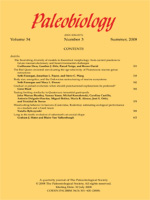Temporal variation in sampling intensity and geologically controlled rates of fossil preservation distort macroevolutionary patterns in the fossil record. Here, we use a comprehensive, list-based compilation of taxonomically and stratigraphically vetted global crinoid genus occurrences to evaluate and correct for the effects of variable and incomplete sampling from the Ordovician through Early Silurian. After standardizing the number of occurrences or the number of biofacies used to estimate the stratigraphic ranges of genera and after adjusting rates of turnover to account for the incomplete preservation of true extinction and origination pulses, we find support for several important revisions to the macroevolutionary history of crinoids. First, in contrast to the uncorrected data, sample-standardized genus richness does not appear to increase by more than 20% after an abrupt Middle Ordovician (Harnagian) diversification. Second, the only significant short-term change in genus richness following the Harnagian increase is a ≥24% decline from the Rawtheyan to the Hirnantian. Third, volatility in rates of genus extinction is increased after adjusting for preservation and there remain significant peaks of extinction in the Rawtheyan, which marks the end-Ordovician extinction, and in the middle of the Early Silurian. Finally, significant increases in origination rates occur in the Early Silurian. These results reaffirm the importance of the end-Ordovician extinction for crinoids, but they also highlight the comparatively poorly sampled Early Silurian as a time of turnover among crinoids.
Crinoid genus extinction rates are positively correlated with area-weighted rates of sedimentary package truncation, suggesting that extinction may have been controlled by physical environmental changes, such as the contraction of unique epicontinental sea habitats. The lack of a correlation between genus origination and sedimentary package initiation reinforces this hypothesis and suggests that other factors, such as evolutionary innovations and biotic interactions during the Ordovician radiation, may have been more important in controlling the diversification of crinoids.





